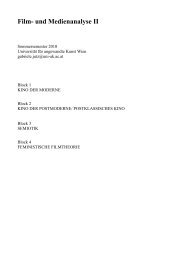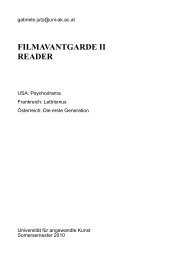Filmanalyse - Gabriele Jutz
Filmanalyse - Gabriele Jutz
Filmanalyse - Gabriele Jutz
You also want an ePaper? Increase the reach of your titles
YUMPU automatically turns print PDFs into web optimized ePapers that Google loves.
Tom GUNNING: Non-Continuity, Continuity, Discontinuity: A theory of genres in early<br />
film. In: IRIS, vol. 2, n° 1, 1984, S. 101-112.<br />
Tom Gunning<br />
Non-Continuity, Continuity,<br />
Discontinuity:<br />
A Theory of Genres in Early Film<br />
In my essay entitled «The Non-Continuous Style of Early Film »/i, I<br />
surveyed a group of what could be called anomalies in early film -<br />
elements which, from the viewpoint of the later dominant style of<br />
film-making (which we could call - with caution and reservation - the<br />
classical style of continuity) seemed deviant. Inspired partly by the<br />
work of Noel Burch and partly by own interest in later « deviant » styles<br />
of film-making in the avant-garde, I felt it was important not to see<br />
these anomalies as primitive mistakes groping towards the later established<br />
ideal of match cutting and diegetic unity but as indications of<br />
another direction in film narrative than that of later dominant cinema,<br />
a road not taken by the major film industries.<br />
My essay was announced as preliminary, and in it I indicated my<br />
uncertainty as to whether the group of anomalies I surveyed could<br />
actually be thought of as forming an organic and unified style in early<br />
film. It now seems to me that the importance of the elements I discussed<br />
is not primarily that they sketch an alternate approach to narrative<br />
than that of the classical style, but rather that they reveal how complex<br />
and dialectical the development of the classical style is. Rather than<br />
serving as markers on a deviant route in film history, the elements of<br />
non-continuity in early film punctuate the body of film history, becoming<br />
a series of blind spots. For traditional historians who see film as<br />
moving towards an ideal of continuity, the anomalies can only be seen<br />
as errors or failed attempts. For recent theorists such anomalies are<br />
/1. This paper has since been published in French : « Le style non-continudu cinéma<br />
des premiers temps », in Les Cahiers c/e la Cinematheque (Perpignan, hiver 1979) and in<br />
English in Cinema 190011906 : An Analytical Study, ed. Roger Holman, Bruxelles,<br />
F.I.A.F., 1982, Volume I, which anthologizes all of the papers delivered at the Brighton<br />
Conference.





![+ [R] - Gabriele Jutz](https://img.yumpu.com/7473913/1/190x245/-r-gabriele-jutz.jpg?quality=85)
![+ [R] - Gabriele Jutz - Sonance.net](https://img.yumpu.com/5987492/1/184x260/-r-gabriele-jutz-sonancenet.jpg?quality=85)